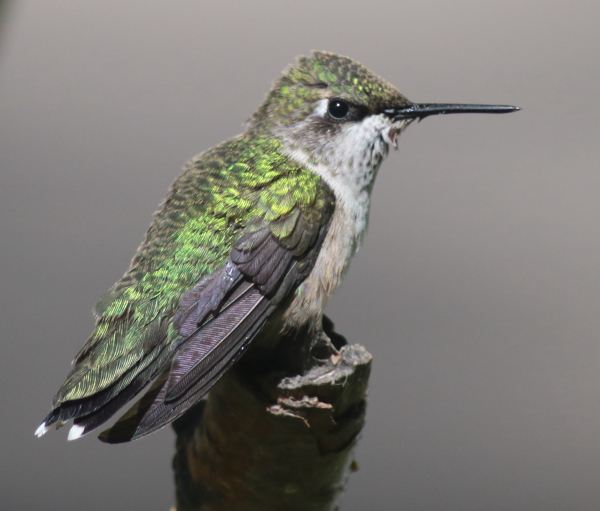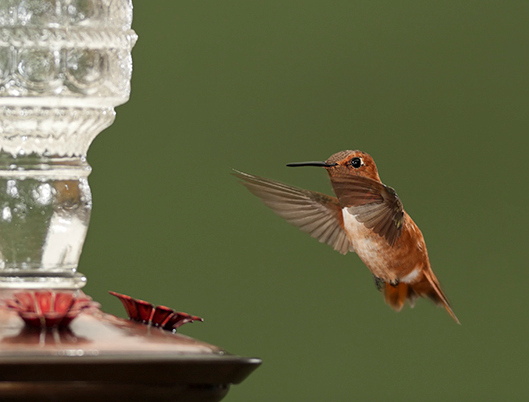
A female Ruby-throated Hummingbird and a male Rufous Hummingbird are symbolic of the kinds of hummingbirds that are staging at feeders and flower gardens across the country as they reposition southward.

|
It’s a prime time to add a hummingbird feeder to your yard if you don’t already have one. Many birders that provide a nectar feeder now add a second one to give hummingbirds a bit more space at the nectar bar. Hummingbirds are naturally territorial around food sources, so if you add a second feeder, position it a distance apart from your original nectar feeder to minimize chases and sparring. It might be a great time to add a window feeder for a closer look at hummers visiting your yard – even at your business, office, or school classroom.
As always, keep all your nectar feeders filled with fresh sugar-water, and clean them often during the early primetime fall hummingbird activities. Most of all, enjoy any uptick in hummingbird activities at your feeding station, in your flower garden, and in your yard. When hummers are around, get your camera out and try your hand at photographing hummingbirds – it may be easier to get a pleasing photo or two than you think.
Hummingbirds will usually permit you to approach a feeder fairly close, then it’s a matter of choosing a position where the sun is behind you and the birds are in front of you, and you should be good to go. Obviously, use the fastest shutter speed the lighting permits, which can be bolstered by using an aperture of f6, for example. Try poking a long stick in the ground a few feet from your nectar feeder to get a portrait of hummingbirds as they perch there between feeding bouts.
If you don’t have hummingbirds stopping by, you can do some virtual hummingbirding at the upcoming hummingbird festival via Zoom, presented by the cities of Rockport and Fulton in Texas, and online via live cams at lively feeding stations in West Texas and Studio City, California, which we describe below.
The HummerBird Celebration in Rockport and Fulton, Texas
Coming up in the virtual hummingbird world, you can learn about how you to participate in the upcoming HummerBird Celebration – one of the oldest birding festivals in America – that takes place on line via Zoom September 17 to 20. Learn more at https://www.rockport-fulton.org/HB
West Texas Hummingbird Feeders
Black-chinned, Broad-tailed, and Rufous Hummingbirds are stars of the show at the West Texas Hummingbird Live Cam now. You may even get a look at a rare Lucifer Hummingbird or one of the big Rivoli’s Hummingbirds that visit the feeders. Be sure to check out the Video Highlights section as you scroll down from the live cam to see some true highlights at these infamous hummingbird feeders in west Texas.
Keep scrolling toward the bottom of the webpage to find photos of each potential hummingbird species you may see, although only males are pictured – and they are all perched. While you are watching the live cam, you may find that most of the hummers are females, and they may be moving at speeds only other hummingbirds can rival; but actually, it’s a great way to familiarize yourself with the nuances of identifying different “western” species.
Hosted by West Texas Avian Research, Perky-Pet, and the Cornell Lab of Ornithology, you can view the live cam and all the hummingbird videos and information at https://www.allaboutbirds.org/cams/west-texas-hummingbirds/ The West Texas Hummingbird Feeder Cam is located in the mountains outside Fort Davis, Texas, at an elevation of over 5,500 feet. This site actually hosts a total of 30 hummingbird feeders, and during peak migration they can attract hundreds of hummingbirds composed of a dozen species that are migrating through the arid mountain region. For more than 10 years, researchers from West Texas Avian Research have been banding hummingbirds at this site and others in the Trans-Pecos region of Texas to study the status and distribution of hummingbirds.
Los Angeles Hummer Feeders
In the heart of LA, in a corner of Studio City, Carol Turek provides a remarkable live cam look at a selection of her many HummingbirdSpot feeders and the birds that feed there – mostly Anna’s and Allen’s Hummingbirds, but watch for Rufous Hummers and other species too, along with an occasional Hooded Oriole. It’s also fun to see some hummingbirds land on the “hummingbird swings” that are set up among the feeders.
There is a wealth of information about hummingbirds on the HummingbirdSpot website, including species we find in the United States and Canada, but also through the rest of the Western Hemisphere, with many impressive photos of iconic and little known species among the 349 species of hummingbirds. Be sure to check out the variety of products available at the HummingbirdSpot Store on this website too, all at https://www.hummingbirdspot.com/
The Family of Hummingbirds
Speaking of the remarkable variety of hummingbirds, you should really check out the information available about the 349 species of hummingbirds found in the world – although hummingbirds are only found in the New World, the Western Hemisphere that is, from Canada to Argentina. The species diversity of hummingbirds is greatest along the Equator, and the number of species found in a given location tends to be fewer as you move farther north and south from the Equator. Even at the Equator, the diversity of hummingbirds is greatest where the Amazon basin meets and elevates into the Andes Mountains, among the varied habitats found at different altitudes.
You can get an overview of the hummingbird family and information about individual species – including the iconic Ruby-throated, Anna’s, and Rufous Hummingbirds at Birds of the World, the best source of information about all the birds found worldwide, at https://birdsoftheworld.org/bow/species/trochi1/cur/introduction including the species profile for Ruby-throated Hummingbirds at https://birdsoftheworld.org/bow/species/rthhum/cur/introduction although you can review similar information about any species – just type in the name of the species you are interested in learning more about in the window at the top of any page within the Birds of the World website.
Enjoy the early fall hummingbirds that grace your yard, and the birds you can monitor online too. And take a little time to learn more about the hummingbirds of the Americas, including the birds that visit your nectar feeders – they are truly fascinating and unique birds!
Share your birding experiences and photos at editorstbw2@gmail.com